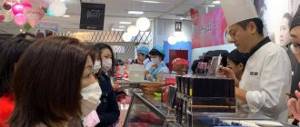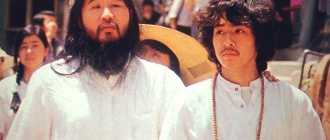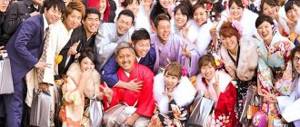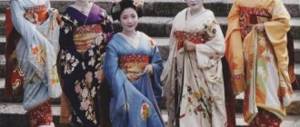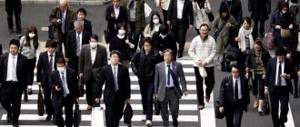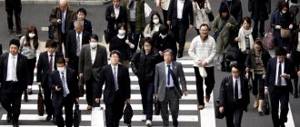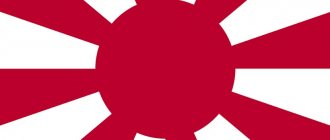Various Halloween events take place from September to October. Previously, the holiday was most often celebrated in America and Europe, but in the process of mixing the cultures of the West and the East, it also appeared in Japan.
Every year, bars, cafes and restaurants in the Land of the Rising Sun host various events dedicated to this topic. Of course, we can’t do without traditional jack-o’-lanterns, which are specially used to carve out ominous faces.
In Japan, this holiday is becoming more and more popular every year, and mostly teenagers and young people become participants in the celebrations. It should be noted here that the Japanese are enthusiastic about everything new and are ready to adopt any traditions if they are really interested in it. There are even themed shops where you can buy special sweets, masquerade costumes, terrifying decorations and much more on the eve of the holiday.
How is Japanese Halloween different from Western Halloween?
When it comes to Halloween, most of us imagine the American version of this holiday with its characteristic attributes. But in Japan they also celebrate Halloween, and they do it completely differently than in the West and in Russia.
And the first thing to note is that the Land of the Rising Sun does not have a “trick or treat” tradition. Yes, yes, Japanese children do not gather in groups to fill buckets with assorted sweets after going to their neighbors’ houses. Why? The answer lies in the peculiarities of the local mentality. The Japanese are accustomed to living separately and extremely dislike causing inconvenience to each other. Children growing up in such an environment cannot even imagine just knocking on their neighbors’ doors.
It would seem that Western culture and its characteristic relaxedness are increasingly penetrating into Japan. Has nothing really changed in the 21st century? No, and it’s not just a matter of mentality. The Japanese are increasingly moving from rural areas to densely populated cities and working very hard. As a result, the average resident of Tokyo or Yokohama simply does not know his neighbors, and sometimes does not even see them.
Some Japanese still exchange candy with relatives and work colleagues. But this is rather an exception.
Halloween in Japan. How the Japanese celebrate - origins and features
It would seem, what could be in common between conservative Japan and the reckless Western holiday of Halloween? Nevertheless, Halloween is celebrated in Japan on a grand scale. To be honest, I don’t like this holiday and I don’t understand how you can have fun, calling on evil spirits, dressing up as monsters, it somehow emanates coldness and horror. At least for me it's something out of a 90's horror movie. That is why it was surprising for me on the streets of Japanese cities, from the capital to the provincial ones, to see how the country dresses up for the holiday. Shop windows, cafes, and railway stations are dressed in traditional orange and black. Cute pumpkins wink with their little eyes and invite you to join in the general fun.
The kindergarten group we met in the city of Odawara, led by a teacher, were dressed in Halloween costumes and happily waved their arms and shouted “Harrow” to us. Surprisingly cute.
Everyone, young and old, celebrates. The kids look cute, and the youth are rocking at 100 percent.
People put on carnival costumes long before October 31 and walk around the city without any inhibitions. This was the beginning of my trip to Japan and I couldn’t take out a camera and take a picture, but two incidents amazed me, confused me, one might even say shocked me. The first was when, at one of the subway stations in Tokyo, a group of young guys were dressed, it’s hard to say what, but instead of trousers, one of them was wearing a cardboard box, barely covering the private part, like a miniskirt, and so they wandered around the capital, We met them again at another station; they were Japanese.
It was something similar to this “suit”, the boys were walking long before October 31st.
And another case, when in a crowded subway car stood a foreigner in a white jumpsuit, splattered from head to toe with “blood” - a sort of Jason, only he was missing a chainsaw. The Japanese treat such scenes normally with humor and understanding. Of course, if this had not happened during Halloween, I think this would have been impossible.
Despite the fact that the Internet is replete with pictures of cosplayers or people dressed in strange outfits, in fact such a demonstration on the city streets is only allowed at certain times.
All Saints' Day has not always been celebrated in Japan, but over the past 10 years, interest in the holiday has been growing every year. This, in my opinion, is all due to the greater penetration of the West into the foundations of Japan and the colorfulness of the action. The Japanese love and know how to have fun and relax. Look at the number of matsuri (holidays, festivals) in Japan. And every holiday is a crowded colorful procession with elements of theatricality. And the Japanese simply could not miss this opportunity when they could dress in suits and parade through the streets of the city.
It all started back in 1950, when in the Harajuku quarter, which had many facilities for US military personnel, and therefore the Americans themselves, a small bookstore opened that sold foreign literature and high-quality Japanese toys. Away from their homeland, Americans missed their holidays and often asked store owners why they weren’t selling Halloween-related items.
Given the interest of foreigners, the store owners went to America to find out about this strange holiday, and at the same time buy the corresponding paraphernalia. Even before the 70s, this essentially pioneering store began selling items for the autumn festival of evil spirits. Since 1983, costume parades for children began to be held in front of the store.
Initially, no more than 100 people took part in the procession, but every year the ranks of those who wanted to have fun swelled. Of course, the first participants in Halloween were foreigners, but gradually the Japanese began to join them. In 1997, a Halloween costume party was held at Tokyo Disneyland, which was a kind of permission to dress up in strange outfits and have fun on October 31st on Halloween.
Until 2002, there was no specific location for the holiday, but during the celebration of the World Cup, the media showed how young dressed-up people staged a procession at the Shibuya intersection. After which the famous intersection became a place where festively inclined people in carnival costumes flocked.
Currently, more than 70,000 thousand people take part in the Halloween procession, half of them are dressed in carnival outfits, the other half, apparently, come to look at the mummers. This is a truly fascinating colorful spectacle, with one BUT.
Just like “sakura viewing,” the fun is fueled by strong drinks, which led to an incident last year. A crowd of thousands started fights, overturned a truck, a stampede occurred, and some were arrested for participating in the riots. People had so much fun that this year local authorities banned the sale of alcoholic beverages. From October 25 to November 1, it is not only prohibited to sell in the Shibuya area, but also to drink. Also, under threat of criminal punishment, it is forbidden to touch road signs, street lamps and other objects that “demonstrators” can use in their fun. Young people are urged not to stay on the streets for long, but to return home with the last train.
This ban is treated differently. Some consider this to be correct and urge people to behave more quietly so that in the future more and more restrictions do not occur that will reduce the celebration to a boring pastime; others believe that those who are afraid of getting into trouble at a time of general fun should stay at home.
You rarely see trash cans on the streets of Tokyo and other Japanese cities, and this is a big problem during public events. Perhaps someone would have thrown the garbage into a bin, but in the absence of such, the place of the procession turns into a big garbage dump in the morning and the volunteers are then forced to clean up the mess. To draw attention to the problem, volunteers collect garbage after Halloween into pumpkin bags.
They throw away everything: jars, used suits; last year about 7.8 tons of garbage were collected. Local authorities plan to install bins this year so that used suits and other unnecessary things can be stored; in the future, they plan to sell them, and use the proceeds to restore order on the streets.
Halloween in Japan is different from how it is celebrated in America and Western Europe. The Japanese mentality does not allow “barging” into the house (even if very politely) of strangers and begging for treats and candies in exchange for the fact that visitors will not cause trouble for the residents, that is, comic extortion Trick-or-treat (sweet or nasty) in Japan did not take root.
Also, Halloween costumes in Japan are very different from their Western counterparts. The country of cosplayers and otakus could not stay away from the costume ball and came up with such a variety that it was dizzying. If initially the main attributes of the holiday were all kinds of evil spirits, emaciated faces and something supernatural, then today’s bright outfits are a colorful show. Here you will see not only representatives of the dark force, but many positive characters - fairies, butterflies, brides - just bright and beautiful youth.
Halloween, like any holiday, is a business. During the period from September to October, seasonal products appear - buns, sweets, pies, cakes, drinks. Unlike other holidays, the choice here is not yet very large, but everything is just beginning. Cafes, restaurants, hotels and other establishments are decorated in a holiday style; the main attribute is, of course, a pumpkin. In some institutions, fancy dress is encouraged. The stores have a wide selection of costumes and paraphernalia, this can be seen in principle by looking at the video or photographs.
Already now there are a lot of costumed young people on the streets of Tokyo, the streets are lively and the police are constantly monitoring order. No violations or disturbances have been noticed so far. Trash cans have already been put out to collect the props that accompany the celebration. Japan on the eve of the autumn bacchanalia.
It’s hard to believe that the processions will take place soberly, but there are a couple of days left before the climax.
It is noteworthy that the city administration does not seek to ban the holiday, but rather welcomes the emergence of a new tradition and tries to adjust the event with the least adverse outcome for both the participants themselves and the residents of the Shibuya district. But in other cities of Japan there are still no restrictions on celebrating Halloween; in particular, in Osaka they have a very wide and bright party.
How do you feel about celebrating Halloween? Do you think it can take root with us or still... no?
Halloween outfits in Japan
The Japanese love to dress up. Considering that this is where cosplay originated, it is not surprising that the locals are passionate about crazy outfits. Walking down the street on Halloween, you can easily pass women in lingerie and fake blood, a teenager with his head held under his armpit, or a man in a fiery red latex costume.
Separately, it should be said about the costume parades that are organized throughout the country. In Tokyo, for example, they take place in different areas and have their own characteristics. Fashionistas come to Roppongi, and cosplayers come to Ikebukuro. The largest number of participants is in the Shibuya parade, which takes place at night and is a huge street party.
If you suddenly find yourself in the Land of the Rising Sun on Halloween, then the best place to spend the night is in Shibuya. This way you can fully enjoy the Japanese Halloween atmosphere. The main thing is to be prepared that there will be a lot of happy and drunk people around. Also, take more money with you for souvenirs and sweets. Kit-Kat and dozens of local manufacturers release special edition Halloween-themed products each year.
Obon - Japan's own Halloween
There is an analogue of Halloween in almost every country. In Japan it is Obon. Literally, a three-day holiday of remembrance of the dead. But unlike Halloween, it is not so hyped and commercialized. But it has a special meaning.
According to tradition, on this day the souls of the departed descend to earth, they come to visit the living - their relatives and friends. On this day, it is customary to light lanterns and hang them on the street to make it easier for unusual guests to find their way to the house. The holiday lasts three days and ends with the performance of a special dance - bon odori. It helps to calm the souls of the ancestors and guide them back. Their way home is illuminated by special colored lanterns, which the Japanese launch into the water at the end of the third day - toro nagashi.
Obon, unlike Halloween, is celebrated in mid-August, some territories celebrate it in mid-July. This is a non-public holiday, but some companies still provide official days off to all their employees.
Attributes of Japanese Halloween
The main symbols of Halloween in Japan are:
- Pumpkin. Some traditions cannot be escaped. The pumpkins are gutted, a creepy face is cut out for them and a candle is placed inside.
- Symbols of death. Skulls, skeletons, black robes, vampire fangs, witch costumes, bat figurines - this and much more are in great demand several months before the holiday.
- Thematic makeup. The Japanese paint their faces, regardless of the presence or absence of a costume. Moreover, sometimes makeup can be both realistic and incredibly creepy.
The Japanese made their own adjustments to the holiday, but the essence remained unchanged - Halloween here is both scary and fun.
Caroling is not accepted here
Almost always, the first thing people want to know is whether the Japanese engage in trick-or-treating or caroling, since many of us think of Halloween as a holiday with such a tradition. However, the practice of going door to door begging for sweets and collecting huge amounts of candy does not exist here. It can be assumed that the absence of this part of the celebration in Japan will not change in the near future, since the Japanese have an overly developed sense of tact (there is even a special term in Japanese that can be literally translated as “being a source of concern for someone”). Therefore, the tradition of going door to door to ask for candy is a huge inconvenience for many.
Garlic and 6 other foods that will support liver health
Lungs, heart and more: what people who have recovered from Covid should check
The fight against drowsiness and daydreaming: forecast from Vasilisa Volodina for the week
Other celebration features
Tokyo Disneyland has been holding events dedicated to the holiday of evil spirits for 14 years. The park area is decorated with pumpkins, and standard Disney characters are dressed in costumes appropriate for the event.
But the most famous Halloween procession takes place in the city of Kawasaki. Every year it attracts more than three thousand participants. Young people come from all over the country, constantly surprising the audience with non-standard outfits.
The holiday is not yet as popular as traditional celebrations for these places, such as the cherry blossom festival, but everything is to come. You can already see how artistic techniques are gradually being adapted to the realities of Japan, and people are getting used to Halloween and becoming active participants in the celebrations. By the way, the Japanese national holiday O-bon is very similar to Halloween and now you will understand why.
O-bon is an amazing combination of sorrow and fun. The fact is that on this day people visit the graves of their deceased relatives, and also prepare special dishes and simply have fun so that their loved ones who have left them will not be so sad. No one wears any special costumes on O-bon, everything is limited to a summer kimono, but the Japanese perform the bon dance on this day.
If we go back to Halloween, here in the Land of the Rising Sun our own traditions have already appeared. For example, young people often organize historical plays on this day with themes related to the holiday. The performances look very interesting and can bewitch, thanks to the amazingly beautiful costumes of the main characters and no less colorful scenery.
The Japanese know a lot about artistic design, and it’s not for nothing that a huge number of fashion shows take place here. Cosplay also originated in this country (creating the image of a character from a movie/series/video game/cartoon/comic book and any other work). If you happen to visit Japan for Halloween, you will never forget the atmosphere!
Note: the New Year is just around the corner and that means it’s time to start preparing gifts for the people close to you. For those who will not be able to give gifts, be sure to send a greeting card, which you can choose on the website https://www.pozdravunchik.ru/pozdravleniya/prazdnik/noviygod/s-nastupaushim/cards.html.
<Japan celebrates autumn Higan
A traditional children's holiday was held in Japan>
How do the Japanese celebrate Halloween?
As in most countries, Halloween for the Japanese is a reason to have fun and celebrate. They are preparing very thoroughly for this date. Paraphernalia and decorations are of great importance to local residents. A wide variety of goods and specific symbols appear in local stores in advance.
Neither October 31 nor November 1 are official holidays in the country, so most public events are postponed until the next weekend. These days, carnivals and festive processions take place in major cities. All clubs, cafes, bars and restaurants try to prepare thematic programs. There is even a special festival of theatrical performances dedicated to this holiday.
The classic traditions, which are common in European and English-speaking countries, associated with begging for sweets, have not taken root here, although the adapted phrase: “Trick-or-treating” - “Trouble or treat” - can be heard from children of primary school age.
Attributes of Japanese Halloween
Pumpkin is the main symbol of the holiday. The seeds are also taken out of it, a scary face is cut out and a candle is lit inside. Pumpkins are also used in interior design elements.
Objects that are symbols of death and evil spirits are very common. Skull, scythe, hood, bat, vampire fangs, witches and their accessories such as broom and hat, any signs of the dead. To produce the desired effect, young people not only select appropriate costumes, but also use makeup; make-up can be very impressive and even shocking.
Halloween in Japan for tourists
Having arrived anywhere in this country on the eve of Halloween, an inexperienced tourist who has not previously seen how holidays and carnival processions take place in Japan will have plenty of impressions, including acute ones. Those who want to see something truly amazing should get into the very center of the festive events and the gathering of evil spirits.
Halloween in Kawasaki, south of Tokyo. The largest carnival procession takes place here. Kawasaki is also considered one of the first cities in Japan to celebrate the holiday on such a large scale. The first parade took place in 1997. Today it attracts up to 3 thousand participants annually and about 130-150 thousand spectators, who also dress in scary costumes.
Another place that gets a major makeover for Halloween, attracts thousands of visitors and makes fabulous sales on All Hallows' Eve is Disneyland in Tokyo. The amusement park first tried this holiday format in 2000, after which, together with Universal Studios Japan and with its financing, emphasis was placed on popularizing the holiday. And today, Halloween at Tokyo Disneyland is one of the most anticipated holidays of the year.
Do the Japanese Tell Ghost Stories on Halloween?
Japan has a long tradition of spooky folklore, but the Japanese actually celebrate the Buddhist festival of Obon in the summer. During this time, horror films and all kinds of mystical shows are offered in cinemas and on television, and themed menus appear in bars and restaurants. Halloween is often limited to costumes, although some entertainment venues hold themed parties.
Found a violation? Report content
Street celebrations
Most holidays are celebrated outside the home. Although the street parties that take place around Halloween never start out as formal events, they fit into the already existing culture of matsuri (Japanese festival). Drinking alcohol in public is legal and accompanies many street events in the country.
In fact, Halloween celebrations develop into street parties in the style of Japanese festivals. The explosion in popularity of the holiday in Tokyo and other major cities means that crowds of costumed people gather in busy areas. These days it is almost impossible to get into restaurants, bars or clubs in popular places without making a reservation or purchasing a ticket in advance.
Black monochrome and oversized jacket: stylish looks from Instagram stars for March 2021
Gorbachev is 90! “He who dances to jazz will regret it tomorrow”: quotes from the leader of the USSR
A beautiful soft ottoman is easy to make with your own hands: simple instructions
How the holiday is celebrated in schools
However, celebrations tend to be different at international schools in Japan. Parties are often held there so that children can get acquainted with the peculiarities of Halloween according to the traditions of Western countries.
For example, at the school where my friend taught, the teachers and students dressed up as witches, princesses, mummies and vampires. They visited each other's classrooms and exchanged treats and other small gifts.
